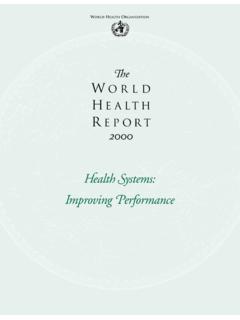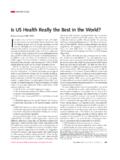Transcription of The World Oral Health Report 2003
1 WHO/NMH/NPH/ World Health Organization The World oral Health Report 2003 . Continuous improvement of oral Health in the 21st century the approach of the WHO Global oral Health Programme WHO/NMH/NPH/ The World oral Health Report 2003 . Continuous improvement of oral Health in the 21st century - the approach of the WHO Global oral Health Programme Poul Erik Petersen oral Health Programme Noncommunicable Disease Prevention and Health Promotion World Health Organization Geneva, Switzerland World Health Organization 2003 . All rights reserved. Publications of the World Health Organization can be obtained from Marketing and Dissemination, World Health Organization, 20 Avenue Appia, 1211 Geneva 27, Switzerland (tel: +41 22 791 2476.)
2 Fax: +41 22 791 4857; email: Requests for permission to reproduce or translate WHO. publications whether for sale or for noncommercial distribution should be addressed to Publications, at the above address (fax: +41 22 791 4806; email: The designations employed and the presentation of the material in this publication do not imply the expression of any opinion whatsoever on the part of the World Health Organization concerning the legal status of any country, territory, city or area or of its authorities, or concerning the delimitation of its frontiers or boundaries. Dotted lines on maps represent approximate border lines for which there may not yet be full agreement.)
3 The mention of specific companies or of certain manufacturers' products does not imply that they are endorsed or recommended by the World Health Organization in preference to others of a similar nature that are not mentioned. Errors and omissions excepted, the names of proprietary products are distinguished by initial capital letters. The World Health Organization does not warrant that the information contained in this publication is complete and correct and shall not be liable for any damages incurred as a result of its use. The named authors alone are responsible for the views expressed in this publication. CONTENTS.
4 PREFACE. BACKGROUND 1. POLICY BASIS FOR THE WHO oral Health PROGRAMME 3. oral Health is integral and essential to general Health 3. oral Health is a determinant factor for quality of life 3. oral Health - general Health 3. Proper oral Health care reduces premature mortality 3. What is the burden of oral disease? 3. oral disease burdens and common risk factors 9. oral Health surveillance and goals 10. THE POLICY FRAMEWORK FOR THE WHO oral Health PROGRAMME 14. STRATEGIES AND APPROACHES IN oral DISEASE PREVENTION AND. Health PROMOTION 15. Health promotion and oral Health 17. PRIORITY ACTION AREAS FOR GLOBAL oral Health 19.
5 oral Health and fluorides 19. Diet, nutrition and oral Health 20. Tobacco and oral Health 21. oral Health through Health Promoting Schools 23. oral Health of youth 24. oral Health improvement amongst the elderly 25. oral Health , general Health and quality of life 26. oral Health systems 27. HIV/AIDS and oral Health 28. oral Health information systems, evidence for oral Health policy and formulation of goals 29. Research for oral Health 31. CONCLUSION 33. REFERENCES 34. WHO/NMH/NPH/ The World oral Health Report 2003 . PREFACE. Chronic diseases and injuries are the leading Health problems in all but a few parts of the World .
6 The rapidly changing disease patterns throughout the World are closely linked to changing lifestyles which include diet rich in sugars widespread use of tobacco and increased consumption of alcohol. In addition to socio-environmental determinants, oral disease is highly related to these lifestyle factors which are risks to most chronic diseases as well as protective factors such as appropriate exposure to fluoride and good oral hygiene. oral diseases qualify as major public Health problems owing to their high prevalence and incidence in all regions of the World , as for all diseases, the greatest burden of oral diseases is on disadvantaged and socially marginalized populations.
7 The severe impact in terms of pain and suffering, impairment of function and effect on quality of life must also be considered. Traditional treatment of oral diseases is extremely costly in several industrialized countries and not feasible in most low-income and middle-income countries. The WHO Global Strategy for prevention and control of noncommunicable diseases and the common risk factor approach is a new strategy for managing prevention and control of oral diseases. The WHO oral Health Programme has also strengthened its work for improved oral Health globally through links with other technical programmes within the Department for Noncommunicable Disease Prevention and Health Promotion.
8 This Report outlines the current oral Health situation at global level and the strategies and approaches for better oral Health in the 21st century. Dr Pekka Puska Dr Poul Erik Petersen Director Chief Noncommunicable Disease Prevention oral Health Programme and Health Promotion WHO/NMH/NPH/ The World oral Health Report 2003 . BACKGROUND. The World Health Report 2002 outlined the extent of disease, disability and death in the World today that can be attributed to a number of the most important risks to human health1. This is of great interest in itself but, more importantly, the Report also indicated how much of this burden could be avoided in the next couple of decades if the same risk factors were reduced from now onwards.
9 The Report identified a number of cost-effective interventions to counter some of these risk factors. Intervention is defined broadly as "any Health action - any promotive, preventive, curative, or rehabilitative activity where the primary intent is to improve Health ". Apart from the obvious Health benefits, reducing risks to Health will promote sustainable development and reduce inequities in society. The mission of the WHO Noncommunicable Diseases and Mental Health Cluster is to provide global leadership in the promotion of Health throughout life and to assist Member States to reduce the rate of morbidity, disability and premature mortality caused by these diseases.
10 Emphasis is placed on focusing available resources on the priorities identified by the global strategy for the prevention of noncommunicable diseases (NCDs). The recommended actions for Health comprise: * Formulating risk prevention policies, including more support for scientific research, improved surveillance systems and better access to global information. * Giving top priority to developing effective, committed policies for the prevention of globally increasing high risks to Health such as tobacco consumption; unhealthy diet, unsafe water, lack of sanitation and hygiene, and unsafe sex in connection with HIV/AIDS.













